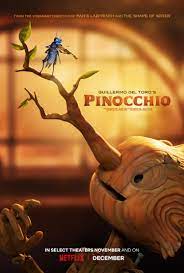
In Italy during World War I, a carpenter named Geppetto (voice of David Bradley) loses his son in a bombing raid. In his son’s honor, he plants a pinecone by his grave. A cricket named Sebastion (voice of Ewan McGregor) comes to live in the tree. Twenty years later, in a drunken rage, Geppetto cuts down the tree to carve a new son out of its wood, but he passes out and does not finish the puppet. A blue Wood Sprite (voice of Tilda Swinton) brings it to life (voice of Gregory Mann) and calls it Pinocchio, telling Sebastian J. Cricket that she will grant him a wish if he will be Pinocchio’s guide.
When he discovers that Pinocchio is alive, Geppetto locks him in a closet and goes to church, but Pinocchio follows him and scares the villagers. The next day, Geppetto sends Pinocchio to school, but an aristocratic showman named Count Volpe (voice of Christoph Waltz), along with his performing monkey Spazzatura (voice of Cate Blanchett), distracts him. Volpe convinces Pinocchio to sign a contract and join his circus. Geppetto and Volpe fight over Pinocchio and the puppet is thrown into the road, where he is run over and killed. In the afterlife, he meets Death (also voiced by Tilda Swinton), sister of the blue Wood Sprite. The Death Angel is wonderful. She tells Pinocchio that he is immortal and will return to the mortal realm when an hourglass has run through, but his time in the afterlife will increase each time he dies.
Pinocchio returns to the mortal realm and decides to join Volpe’s circus so he can make money for Geppetto, and also so he will not be drafted into the Royal Italian Army by the fascist government official Podesta (voice of Ron Perlman). Sebastian and Geppetto search for Pinocchio at sea and are swallowed by the giant Terrible Dogfish. On stage, Pinocchio sings a naughty song about Prime Minister Benito Mussolini (voice of Tom Kenny) and is shot. Returning to Death once more, he is revived but taken by Podesta to a military training camp for boys. He befriends Candlewick (voice of Finn Wolfhard), Podesta’s disappointing son. Influenced by Pinocchio, the boy stands up to his father, but the camp is hit by bombs and Podesta dies.
Pinocchio escapes but is captured by Volpe and when Spazzatura intervenes, they are swallowed by the Terrible Dogfish, where they find Geppetto and Sebastian. Pinocchio tells lies to make his nose grow long enough to make a bridge out of the Dogfish’s blowhole. The Dogfish attacks Pinocchio, who sets off a naval mine and is killed again. He agrees to die forever so he can go back to sea long enough to save Geppetto from downing. When Pinocchio dies permanently, Sebastian uses his wish to bring him back. In the end, after all his loved ones are gone, Pinocchio sets off on new adventures.
The film was created by Guillermo del Toro and Mark Gustafson based on Carlo Collodi’s 1883 novel, as well as inspired by the early Disney animated version. The latter is a bit scary at times as well, but Disney-cute with no dark references to war and death. This is the longest stop-motion animated film. It was cancelled at one point but saved by Netflix, and it was the first Netflix film to win an Oscar. The references to Mussolini and Fascism were del Toro’s idea. He said the plot was a mixture of Pinocchio and Frankenstein. The music by Alexandre Desplat was performed entirely by wooden instruments. Cate Blanchett was so anxious to appear in del Toro’s movie that she took the role of Spazzatura the Monkey, though she would have few lines. “For you,” she said to del Toro, “I’d play a pencil."
The character Carlo was named after Carlo Collodi. Volpe has fox ears and a cane with a fox head as a reference to the early Disney film. It was not released at first in del Toro’s native Mexico because of some things he said in an interview. Pinocchio was the only 3D printed character in the movie. Geppetto was originally supposed to be voiced by Guillermo’s friend John Hurt, but he died and the role was taken over by David Bradley, another star from the Harry Potter films. There are glimpses in the church windows of the Pale Man and Faun from Pan’s Labyrinth. This was Ron Perlman’s eighth film with Guillermo del Toro. The coffin-carrying rabbits are a reference to the Black Rabbit of Death in Watership Down. Spazzatura—the monkey—means garbage. I don’t usually review animated movies, but this is one that Guillermo del Toro wanted to do his whole life. It’s charming, a bit creepy, and fascinating.
